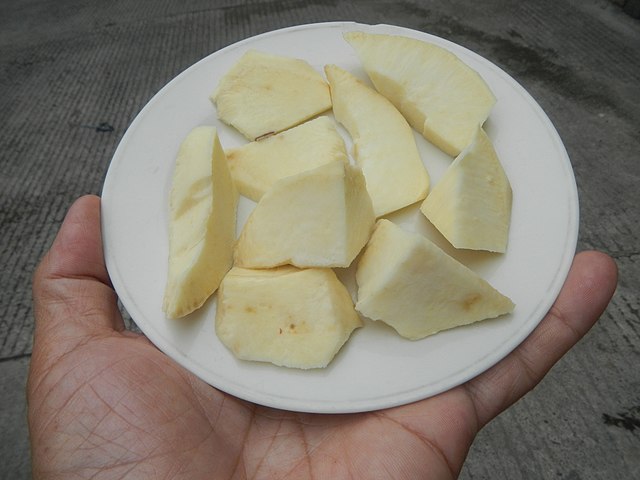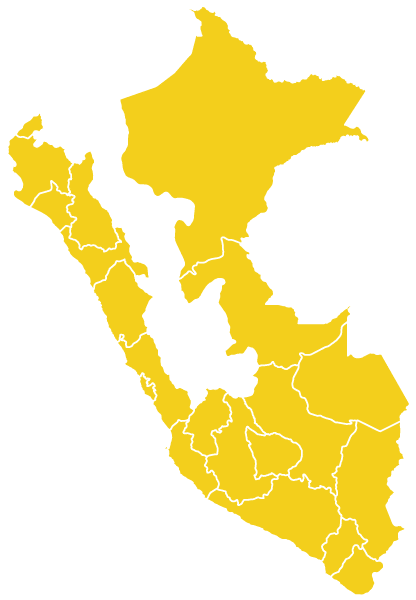Sweet Potato:
What is it?, history, cultivation, nutritional value, uses, recipes, and more...
The sweet potato is an edible plant that is grown mainly for its root, a bulb that provides important starches and sugars to the body. This vegetable is one of the 3 most important tubers in the world and one of the most consumed in developing countries.
Índice
What is Sweet Potato?
The sweet potato plant has a creeping stem, green, tan-green, and purple in color, and is up to 1 meter long. Its leaves have variable shapes and colors and usually measure between 4 and 20 centimeters. They have an oval shape, entire, toothed, lobed or split edge, and their hue varies from pale green to dark green with purple pigmentation.
Sweet potato flowers are bell-shaped, clustered in clusters, and range from pale green to dark purple.
The seeds are between 2 and 4 mm in diameter and have a slightly flattened round shape. They are usually covered by a brown to black waterproof skin.
The tuberous root is the edible part that we normally know as sweet potato, it has a sweet flavor, whitish to yellow skin, and the pulp ranges from yellow, orange, and purple.
Sweet Potato History
The sweet potato originated in the neotropical zone, located in southern Mexico, Central America and South America. There is evidence that in Peru it was cultivated for approximately 8,000 years.
The sweet potato became known in Europe at the end of the 15th century thanks to Christopher Columbus. Shortly after it was introduced to China, at the end of the 16th century.
Recent research confirms the ‘natural’ expansion of sweet potatoes throughout the globe, where they reached the Polynesian islands.

Sweet Potato common name
| Español | Batata, papa dulce, patata dulce, moniato, boniato, patata de Málaga, Patata dulce y minina |
| Quechua | Batata, aje, apichu |
| Aymara | Pua, tipali, tuctuca |
| Shipibo, cashibo y amahuaca | Cari |
| Asháninka | Cjumara, culiti |
| Aguaruna | Inchi |
| Inglés | Quinoa |
| Venezuela (oriente) | Chaco |
Sweet potato scientific name
Ipomoea batatas
Sweet Potato Taxonomy
| Reino | Plantae |
| Subreino | Tracheobionta |
| División | Magnoliophyta |
| Clase | Magnoliopsida |
| Subclase | Asteridae |
| Orden | Solanales |
| Tribu | Ipomoeeae |
| Género | Ipomoea |
| Familia | Convolvulaceae |
| Especie | Ipomoea batatas (L.) Lam. |
Sweet Potato Synonymy
Convolvulus batatas L.
Convolvulus tiliaceus auct. non Willd.
Ipomoea fastigiata (Roxb.) Sweet
Ipomoea tiliacea auct. non (Willd.) Choisy
Ipomoea triloba auct. non L.[8]
Aniseia martinicensis var. nitens (Choisy) O’Donnell
Batatas edulis (Thunb.) Choisy
Batatas edulis var. porphyrorhiza (Griseb.) Ram.Goyena
Convolvulus apiculata M.Martens & Galeotti
Convolvulus attenuatus M. Martens & Galeotti
Convolvulus candicans Sol. ex Sims
Convolvulus denticulatus Desr.
Convolvulus edulis Thunb.
Convolvulus esculentus Salisb.
Convolvulus hederaceus Sessé & Moc.
Convolvulus tuberosus Vell.
Convolvulus varius Vell.
Ipomoea angustisecta Engl.
Ipomoea batatas fo. trifida Moldenke
Ipomoea batatas var. edulis (Thunb.) Makino
Ipomoea batatas var. lobata Gagnep. & Courchet
Ipomoea bolusiana Schinz
Ipomoea bolusiana var. pinnatipartita Verdc.
Ipomoea confertiflora Standl.
Ipomoea davidsoniae Standl.
Ipomoea denticulata (Desr.) Choisy
Ipomoea edulis (Thunb.) Makino
Ipomoea mesenterioides Hallier f.
Ipomoea praetermissa Rendle
Ipomoea purpusii House
Ipomoea setifera Poir.
Ipomoea simplex Hook.
Ipomoea vulsa House
Ipomoea wallii (C. Morren) Hemsl.
Sweet Potato Etymology
Sweet potato: This word comes from the Nahuatl “camotli” which has the same meaning.
Ipomoea: generic name that comes from the Greek ips, ipos meaning “worm” and homoios meaning “similar”, due to the fickle habit of its stems.
Batatas: Latin term that means “sweet potato”, name with which they designate the root in different countries.
Sweet Potato Habitat
- Habitat
Sweet Potato Habitat
In Peru, sweet potato is distributed throughout Peru, both on the coast, in the mountains and in the jungle, especially in tropical and temperate climates, at altitudes ranging from sea level to 2,500 meters above sea level.
Sweet potato thrives in loose, deep soils with a good amount of organic matter; preferring soils with good aeration, good drainage, light and with a high content of organic matter. They can be of the sandy loam to clay loam type, with a pH between 5.2 and 7.7.
Its propagation can be done by aerial stems, from pieces of tuberous roots and also through seeds. It requires 12 to 13 hours of daylight and rainfall between 750 mm and 1,250 mm.
Sweet potato usually grows from sea level to 2,500 m above sea level, however it has better yields between 0 and 900 masl. It does not develop correctly in low temperatures, being able to develop from a minimum temperature of approximately 12ºC. It supports heat if the temperature does not exceed 28ºC.
Geographic distribution of Sweet Potato

Ancash, Apurímac, Arequipa, Ayacucho, Cajamarca, Cusco, Huancavelica, Huánuco, Ica, La Libertad, Lambayeque, Lima, Loreto, Madre de Dios, Moquegua, Piura, Puno, Tacna, Tumbes, Ucayali
Seasonal Availability of Sweet Potato
- It is available all year.
Sweet Potato Varieties
There are approximately 5 thousand varieties, among the main ones are:
-
Yellow sweet potato
-
Purple sweet potato
-
White sweet potato
-
Red sweet potato
-
Rhill sweet potato
-
Wild sweet potato
Sweet Potato Nutritional Value
The sweet potato provides large amounts of starch, vitamins, fibers (cellulose and pectins) and minerals, among which it stands out for its potassium content. Its caloric value is higher than that of the potato and in vitamins it stands out for provitamin A (beta-carotene) and B1, C (ascorbic acid) and E (tocopherol). Thanks to its high content of sucrose, glucose and fructose, it has a sweet taste.
It contains a good level of lysine, which is why it is used as a complement to some cereal flours. Its lipid content is low and it has linoleic, oleic, stearic and palmitoleic acids. It is a great source of digestible fiber, which promotes rapid intestinal transit, prevents colon cancer, controls glucose levels, reduces cholesterol levels and produces a feeling of satiety. Both its peel and its pulp have antioxidants, so it prevents heart disease, diabetes and cancer.
In some countries its leaf is valued to feed both animals and plants. Because it has high levels of iron, provitamin A, vitamin B2, vitamin C and vitamin E, dietary fiber and polyphenols, in some countries its leaf is used to feed animals and vegetables.
Sweet Potato Health Benefits
Sweet potato is anti-inflammatory, antioxidant and natural digestive. In addition, it helps strengthen the immune system.
Contraindications or side effects
Although it is a very low allergenic food, if any allergy occurs, sweet potato intake should be suspended. People who suffer from kidney stones should control their consumption, since it contains oxalate, which contributes to the formation of these. Likewise, it is a high starch food so you should consider its moderate consumption if you want to lose weight.
| 10 Porciones por Kilogramo | |
| Tamaño de porción | 100g |
| Cantidad por porción Calorías |
114 |
| Cantidad por 100g | |
| Energía | 478 kJ |
| Grasa Total | 0.1 g |
| Sodio | ● |
| Carbohidratos totales | 28.3 g |
| Carbohidratos disponibles | ● |
| Fibra Dietaria | ● |
| Proteínas | 1.7 g |
| Calcio | 26 mg |
| Fósforo | 33 mg |
| Zinc | ● |
| Hierro | 2.50 mg |
| Potasio | ● |
| Agua | 68.8 g |
| Cenizas | 1.1 g |
| Vitamina A | 9 μg |
| Tiamina (B1) | 0.14 mg |
| Riboflavina (B2) | 0.04 mg |
| Niacina (B3) | 0.70 mg |
| Vitamina C | 12.90 mg |
| Acido Fólico (B9) | ● |
| β-Caroteno | ● |
| Fuente: Tablas peruanas de composición de alimentos – Centro Nacional de Alimentación y Nutrición – Ministerio de Salud – Perú | |
Derivative products and forms of consumption of Sweet Potato
Sweet Potato Uses
The main use of sweet potato is culinary. Its sweet flavor and flexibility in its preparation make it ideal for various dishes. In addition, it stands out for the nutritional and industrial benefits it provides.
- Culinary
- Medicinal
- Industrial
Culinary use of Sweet Potato
Sweet potato has been consumed in various ways since pre-Hispanic times: cooked, baked, mashed, in jam and other sweets, etc.
The roots are eaten cooked and processed, can be canned or packaged as preserves, and processed for the manufacture of flour and starch.
In Peru it can replace the potato as a garnish for some dishes. It is an indispensable part of national gastronomy and is prepared fried and cooked as an accompaniment to ceviche, pork rinds and also in pachamanca.
Medicinal use of Sweet Potato
Some medicinal uses of this root are to relieve itching, swelling, skin infections, caracha, varicose veins, rheumatism and insect bites such as bedbugs and scorpions. It is also used as a bactericide, fungicide, anti-inflammatory, vulnerary and galactogen.
It also stands out for:
Being a good source of fiber
contain antioxidants
Possess manganese which is useful for metabolizing carbohydrates
Include magnesium that helps combat stress
Provide vitamin A that protects the skin from sun damage
Have anti-cancer properties
Promote the health of the heart and circulatory system
Be suitable for diabetics, as it releases sugar slowly.
Industrial use of Sweet Potato
Among its main industrial uses are:
As a dye: some of the sweet potato varieties exude strong colors that are used to make dyes and dyes
Cosmetics: acne and hair products are made.
Starch: which is used to make food, textiles and stationery
Agro-exports: Sweet potato exports from Peru have risen between January and June 2021 to 6,532,943 kilos, for an FOB value of US$ 2,429,491.



